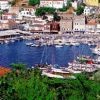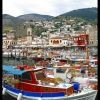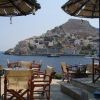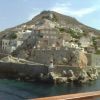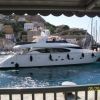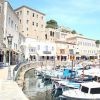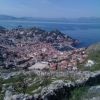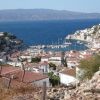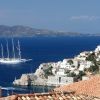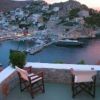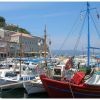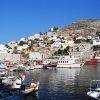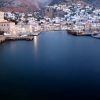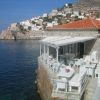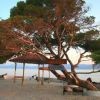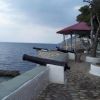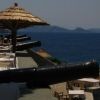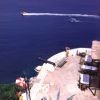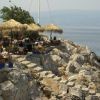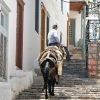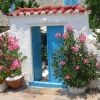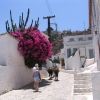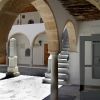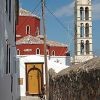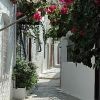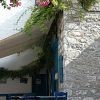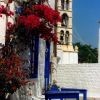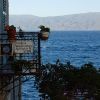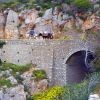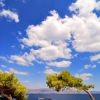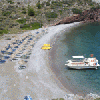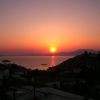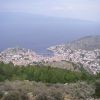ΥΔΡΑ το Νησί, η Πόλη, & το Λιμάνι: Γιατί να την επισκευθείτε - Φωτογραφίες Featured
Hydra is one of the most charming and cosmopolitan islands in the Mediterranean. It has an extremely picturesque traditional historic town, built amphitheatrically on the hills that surround its small graphic harbour. Hydra's town is the sole main settlement on the island. The three other settlements, Vlychos, Kaminia and Mandraki, are very small and are found on a short walking distance from the main town.
In the 50's a movie was shot on the island, starring Sophia Lauren, and ever since then it has become a popular destination among yachters and VIP's from all over the world. Some of them have also bought some wonderful houses there.
Hydra reflects a unique romantic atmosphere. Vehicles are not allowed on the island. The only transportation means are donkeys and sea-taxis. The strict rules for reserving the traditional architecture and the natural environment has kept away touristic development and expansion. Therefore the island offers only a few but good options for accomodation, food, entertainment and nightlife, if compared to other popular Greek destinations. However, it offers quite a large varitery of little shops selling all kinds of things, such as clothes, jewlery, accessories, artworks etc. A few small exclusive hotels have opened recently but most of the tourists are accomodated in the pensions, housed in traditional buidings.
Hydra has apx 3.000 inhabitants and is located at 35 n.m. from Piraeus (Athens port), separated from Peloponese by a narrow strip of sea. It has rocky hillsides and most of its northeastern part, where the town is found, is bare. On the contrary, its south - southwestern part which is almost uninhabited, is verdant with pine forests.
The lack of nice beaches is considered as the main dissadvantage of Hydra. However, it has more than 10 beaches. The most beautiful are Agios Georgios, Agios Nikolaos, Bisti and Limioniza. Moreover, there is a very beautiful isolated sandy beach on Peloponese, right opposite Hydra's Harbour. The problem is that the best beaches of the island are found at a long distance from the town and can only be reached by boat or on foot, through idylic walking paths. Most people know the rocky swimming places, such as Hydronetta, Spilia and Avlaki, which are found in Hydra's town and have crystal clear waters. The beaches of Mandraki, Vlychos, Kaminia, Palamidas, Molos, Nisiza and Kaoumithi, may not be spectacular but definitely offer cool and refreshing waters.
The best things to do in Hydra are:
- Explore the charming Hydra Town & Harbour. Don't miss a cocktail during the sunset, admiring the stunning views from Hydronetta.
- Explore the picturesque settlements and the beaches of Mandraki, Kaminia and Vlychos, which can be reached through wonderful coastal paths.
- Explore the unspoiled nature of the island, by following the numerous signed paths. Most of them pass through historic monasteries and churches and offer stunning views.
- Visit the interesting museums and churches of the Town and admire the impressive historic mansions where important figures of the Greek history used to live.
- Enjoy the island's impressive local customs and festivities, such as the famous "Miaoulia", the Easter celebration, the Puppet Festival etc.
HYDRA TOWN & HARBOUR:
The historic Town of Hydra is one of the most picturesque in the Mediterranean. It is arranged amphitheatrically around the lovely harbour and has reserved its traditional architecture throughout hundreds of years. It is nested among bare rocks and steep mountains, offering an unforgettable picture to the visitors, as the boat enters the port.
The image of the imposing old mansions and the historic defensive bastions with their canons, catches the eye. The spectacle is completed by the numerous fishing boats and luxury yachts packed in the little harbour. Visitors should definitely explore the inner town which is ideal for romantic walks. They will be charmed by the red-tiled houses, the historic mansions, the scenic stone-paved alleys, the colourfull flowers and the stunning views .
The liveliest part of the town is the quay where many cafes, tavernas and bars are found. On the eastern side of the port stands the statue of Andreas Miaoulis, native of Hydra, who was a heroic Admiral of the Greek Revolution against the Turks (1821). The paved road behind the statue leads to Mandraki settlement and beach, through a scenic route which offers stunning sea views (apx 30 min).
On the quay you will also see other important buildings such as: The newly built Historic Archive's Museum of Hydra, the Port Authorities's building and the famous Tsamados Mansion, now housing the Merchant Marine Academy. In the middle of the harbour stands the imposing bell-tower of the beautiful old Cathedral (Monastery) of Kimisi (Dormition) which houses a small Ecclessiastic Museum.
The narrow uphill street at the western part of the port leads to the impressive Tompazi's Mansion which now houses the School of Fine Arts.
One of the most beautiful spots of the town in the "Kiosk" (Periptero in Greek), found on the uphill rocky coast, which was the western part of the old fortification of Hydra. This is the place where some of the most scenic cafes and restaurants of Greece are found. You may also swimm in the rocky beaches of Spilia and Hydronetta which are found near by.
Following the uphill road, among the pine trees, you will see the impressive mansion of Georgios Kountouriotis (19th century), which now houses the Post-Byzantine and Folklore Museum.
Following the pedestrian road from "Periptero" you will reach the scenic Avalki with is rocky beach and then, the small beaches and the picturesque settlement of Kaminia.
On the eastern side of Kimisi Church you will find a street that leads you to Lazaros Kountouriotis Mansion (18th century), which now houses the National Historic Museum. Behind the Mansion lies the beautiful Church of Ipapanti. On the east of the church you will see a beautiful neo-classic building which houses the older pharmacy of Hydra (19th century), which operates until today.
From there, the central road leads to "Kala Pigadia" area, where the old wells that supplied the town with potable water used to lie. Continuing uphill you will reach the old castle town, named Kiafa. The high fences and the external walls of the houses formed a castle protecting the inhabitants from the invaders.
If you like walking, it is worth to follow the nice path leading to the top of the hill. There you will see the churches of Agios Konstantinos of Hydra and Agios Ioannis Nisteftis. Further uphill you will reach the historic Monasteries of Prophitis Elias and Agia Efpraxia, offering stunning panoramic views of Hydra's port, the Saronic Gulf and the Peloponese.
WEATHER - CLIMATE OF HYDRA:
In the summer Hydra is hot and sunny with temperatures that range from 25-38 degrees C. However during July and August the temperature may rise up to 44 degrees C, making sometimes the heat unbearable, especially in the Town. The sea is warm, humidity is low and rainfalls are very rare. Winds are usually soft and warm. In the spring and the autumn the weather and the sea are usually calm and quite warm. May, June and September are considered as the ideal months to visit the island, because then the temperature is ideal.
In the winter the weather is quite cold and rainfalls are more often. However temperatures rarely drop below 5 degrees C. Very often the weather is shiny and quite warm even in the winter months. Snowfalls are very rare.
YACHTING IN HYDRA:
Hydra is one of the most popular yachting destinations because of its charming harbour and its cosmopolitan atmosphere. It offers only a small not organised marina, which is always crowded in the high season. Therefore, finding a place to moor is the main problem. However you should not miss it, because once you've moored you will enjoy one of the most picturesque harbours and towns of the Mediterranean, with a live and cosmopolitan quayside. Moreover Hydra offers the advantages of a mild weather, soft winds and of a convinient location, close to Athens and to other beautiful islands such as Dokos (a popular anchorage), Spetses, Poros, Aegina and Peloponese (Ancient Epidavros, Ermioni etc).
The island offers beautiful anchorages such as: Mandraki, Molos, Agios Georgios, Bali, Bisti (Kavouri) and Agios Nikolaos. You may also swim in the beautiful Limioniza (south) or in the long and isolated sandy beach in Peloponese, opposite Hydra's harbour.
The problem with Hydra is that, in peak days, if you have been lucky to find a place to moor you would not want to move because you will not find another place when you'll return. Therefore, many yachters hire sea taxis for their transportations. However you may always swim in the cosy rocky areas of Hydronetta and Spilia, which are found near the port, or at Avlaki, Mandraki and Kamina, which are found at a walkind distance of apx 15-30 min.
Keep in mind that during the summer, the heat is sometimes unbearable in Hydra's town. The best time to visit the island is during the late spring or early autumn.
MOORING INFO: As alredy mentioned, Hydra's harbour is usually crowded and it is very difficult to find a place in peak days. Therefore, anchors usually tangle and it is very common that boats moor on second, even thrid row. Larger boats anchhor outside the waterbreak with mooring lines tied on the rocks. If you have anchored there, avoid the foul ground that is found in the middle of the port's entrance before the waterbreak.
PROTECTION: Hydra's harbour is protected from all weathers except the North, which create a large rebound of the sea up to 0.80m. In that case, if you cannot avoid this port, you should moor along the leeward side of the north breakwater. HOLDING: Good
FACILITIES: Water: On a few spots on the quay, Electricity/Fuel: N/A, All other facilities (cafes, tavernas, mini markets etc) are conviniently located on the quay or at a walking distance
HYDRA's ADVANTAGES:
- Hydra is one of the most beautiful traditional towns in the Mediterranean. It offers a unique atmosphere, interesting architecture, museums, beautiful old monasteries, long history and is definitely one of the most beautiful places to visit in Greece.
- Life in Hydra is concentrated around the harbour, which is a "meeting point" not only among Athenians but also among people from all over the world. Due to the small size of the town, most of the people on the island know each, new acquaintances are easy, and a "warm and friendly" atmosphere exists.
- Hydra offers a few cozy bars and night clubs, all found on or close to the quay. However, they will not satisfy those who seek a wild nightlife.
- It is ideal for those who love nature, lond walks, trekking and relaxation.
- It is found quite close to Athens and to many other interesting destinations and is ideal for daily or weekend visits because its town, which is the main attraction, can be easily explored
- It offers a mild warm climate with soft winds and is ideal for those who want to avoid the strong meltemi winds of the Aegean.
HYDRA's DISSADVANTAGES:
- Beaches is not Hydra's strong point. It has about 12 beaches but only few of them are good and can only be reached by boat or through long walking paths.
- The lack of motor vehicles on the island may discomfort those who dislike walking. Moreover, a large part of the town, thankfully not the town's center which is behind the quay, is built on the hills. Therefore visitors may need to walk through uphill roads or "hire" a donkeys for their trasportation.
- Summer heat becomes very unpleasant sometimes
- Hydra's Town is stricktly reserved, small sized and the only organised settlement of the island. So, it may not fully satisfy those seeking mass tourism infrastructure, a wild nightlige and a large variety of places to go or things to do.
